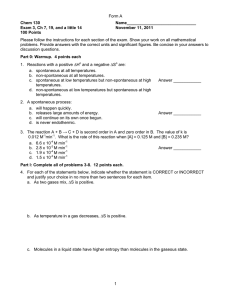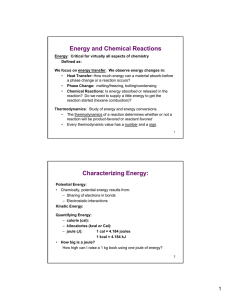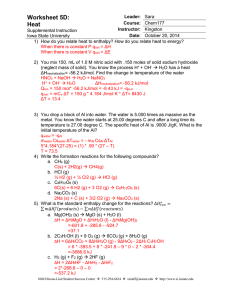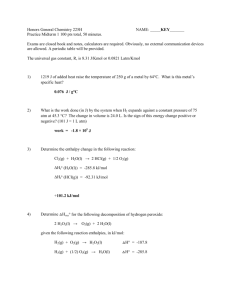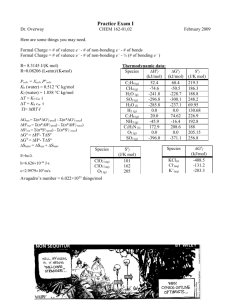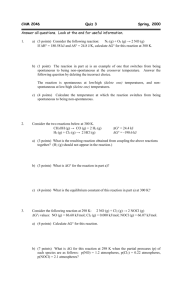Form A Chem 130 Name______________________________
advertisement
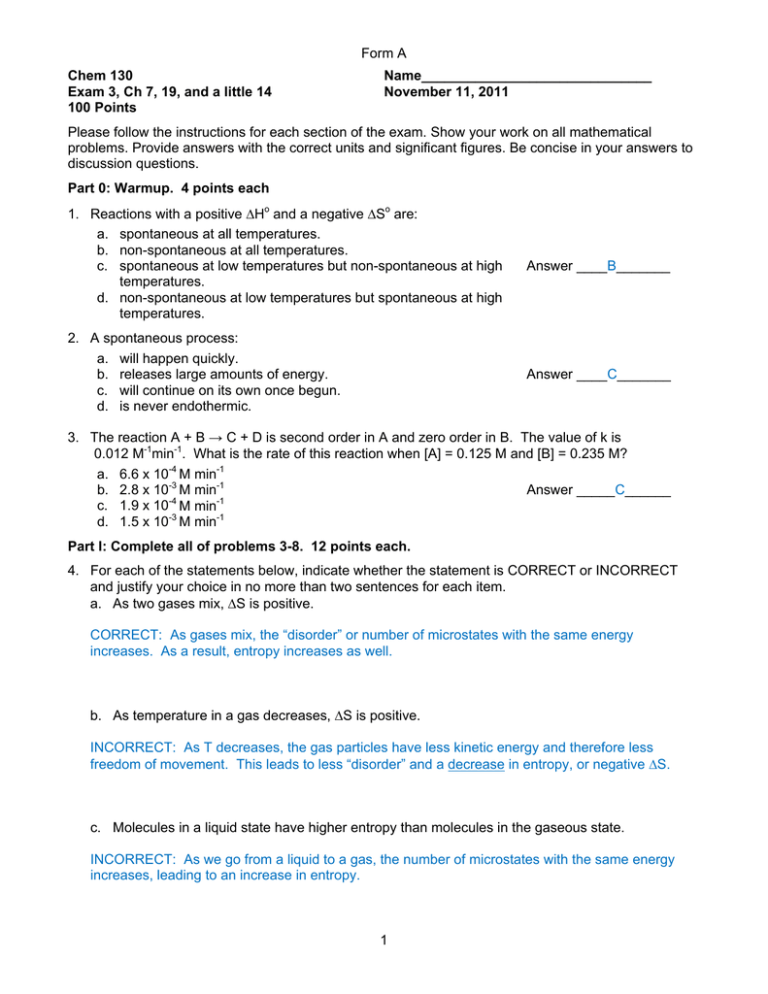
Form A Chem 130 Exam 3, Ch 7, 19, and a little 14 100 Points Name______________________________ November 11, 2011 Please follow the instructions for each section of the exam. Show your work on all mathematical problems. Provide answers with the correct units and significant figures. Be concise in your answers to discussion questions. Part 0: Warmup. 4 points each 1. Reactions with a positive Ho and a negative So are: a. spontaneous at all temperatures. b. non-spontaneous at all temperatures. c. spontaneous at low temperatures but non-spontaneous at high temperatures. d. non-spontaneous at low temperatures but spontaneous at high temperatures. Answer ____B_______ 2. A spontaneous process: a. will happen quickly. b. releases large amounts of energy. c. will continue on its own once begun. d. is never endothermic. Answer ____C_______ 3. The reaction A + B → C + D is second order in A and zero order in B. The value of k is 0.012 M-1min-1. What is the rate of this reaction when [A] = 0.125 M and [B] = 0.235 M? a. 6.6 x 10-4 M min-1 b. 2.8 x 10-3 M min-1 Answer _____C______ c. 1.9 x 10-4 M min-1 d. 1.5 x 10-3 M min-1 Part I: Complete all of problems 3-8. 12 points each. 4. For each of the statements below, indicate whether the statement is CORRECT or INCORRECT and justify your choice in no more than two sentences for each item. a. As two gases mix, S is positive. CORRECT: As gases mix, the “disorder” or number of microstates with the same energy increases. As a result, entropy increases as well. b. As temperature in a gas decreases, S is positive. INCORRECT: As T decreases, the gas particles have less kinetic energy and therefore less freedom of movement. This leads to less “disorder” and a decrease in entropy, or negative S. c. Molecules in a liquid state have higher entropy than molecules in the gaseous state. INCORRECT: As we go from a liquid to a gas, the number of microstates with the same energy increases, leading to an increase in entropy. 1 Form A 5. A coffee-cup calorimeter contains 100.0 mL of 0.300 M HCl at 20.3oC. When 1.82 g zinc metal also at 20.3oC is added and is allowed to react, the temperature rises to 30.5oC. What is the heat of reaction per mole of Zn? Assume no heat is lost during the course of the reaction and that the heat capacity and the density of the solution is the same as that of pure water. Zn(s) + 2H+(aq) → Zn2+(aq) + H2(g) We first need to determine if all of the zinc will react. How many mL HCl will we need? 1.82 g Zn x 1 mol Zn x 2 mol H+ x 1000 mL = 185 mL 65.39 g Zn 1 mol Zn 0.300 mol H+ So, HCl is the limiting reagent: nHClHrxn = -mcT (0.100 L x 0.300 mol HCl/L)Hrxn = -(101.82 g)(4.184 J/goC)(30.5oC -20.3oC) o o Hrxn= -(101.82 g)(4.184 J/g C)(10.2 C) = 144.8 kJ x 2 mol HCl = -289.7 kJ mol HCl 1 mol Zn (0.100 L x 0.300 mol HCl/L) mol Zn (If you make the incorrect assumption that Zn is the limiting reagent, you find DH = -156 kJ/mol Zn.) 6. Determine Ho for the reaction N2H4(l) + 2H2O2(l) → N2(g) + 4H2O(l) from these data: Reaction N2H4(l) + O2(g) → N2(g) + 2H2O(l) H2(g) + ½ O2(g) → H2O(l) H2(g) + O2(g) → H2O2(l) Ho -622.2 kJ -285.8 kJ -187.8 kJ The first reaction is left alone: N2H4(l) + O2(g) → N2(g) + 2H2O(l) -622.2 kJ Double the second reaction 2(H2(g) + ½ O2(g) → H2O(l)) 2(-285.8 kJ) Reverse and double the third rxn: 2(H2O2(l) → H2(g) + O2(g)) -2(-187.8 kJ) Overall Reaction: N2H4(l) + O2(g) + 2H2(g) + O2(g) + 2H2O2(l) → N2(g) + 2H2O(l) + 2H2O(l) + 2H2(g) + 2O2(g) N2H4(l) + 2H2O2(l) → N2(g) + 4H2O(l) Ho = -622.2 kJ + (2(-285.8 kJ)) +(-2(-187.8 kJ)) = -818.2 kJ 2 Form A 7. Determine the standard enthalpy of formation of hexane, C6H14(l), from the information below. Report your result in units of kJ per mole of hexane. 2 C6H14(l) + 19 O2(g) → 12 CO2(g) + 14 H2O(l) Ho = -8326 kJ o -1 -1 Species Hof, kJ mol-1 S f, J mol K Gof, kJ mol-1 O2(g) 0 205.1 0 H2(g) 0 130.7 0 C(s, graphite) 0 5.74 0 CO2(g) -393.5 213.7 -394.4 H2O(l) -285.8 69.91 -237.1 H2O(g) -241.8 188.8 -228.6 Horxn = 12Hof, CO2 + 14Hof,H2O – (2Hof,C6H14 + 19Hof,O2) -8326 kJ = 12(-393.5 kJ) + 14(-285.8 kJ) – (2Hof,C6H14 + 19(0 kJ)) Hof,C6H14 = -8326 kJ - 12(-393.5 kJ) - 14(-285.8 kJ) = -198.6 kJ/mol C6H14 -2 8. For the reaction, 2 NO(g) + Cl2(g) → 2 NOCl(g), Ho = -40.9 kJ. At what temperatures do you expect the reaction to be spontaneous: high, low, all, or none? Justify your answer. If we look at the reaction, there are three moles of gas on the reactant side and only two moles of gas on the product side, therefore, we expect the S for this process to be negative. So, we will have a situation where we have a negative H and a negative S. Since G = H - TS, the spontaneity of the reaction will depend on temperature. In order for G to be negative and have a spontaneous reaction, temperature must be low in order for H - TS to remain negative. Therefore, we expect this reaction to be spontaneous at low temperatures. 3 Form A Part II. Answer two (2) of problems 9-11. Clearly mark the problems you do not want graded. 15 points each. 9. The initial rate of the reaction A + B → C + D is determined for different initial conditions, with the results listed in the table below. Determine the rate law and the rate constant for the reaction. Experiment [A], M [B], M Initial Rate (Ms-1) 1 0.0133 0.0185 3.35 x 10-4 2 0.0133 0.0370 6.75 x 10-4 3 0.0266 0.0370 2.70 x 10-3 4 0.0266 0.0185 1.35 x 10-3 Comparing reactions 1 and 2: [A] remains constant, but [B] changes by (0.0370/0.0185) = 2 times. The rate changes by (6.75 x 10-4/3.35 x 10-4) = 2.01 times. Since the change in rate is the same as the change in concentration, the reaction must be first order in B. Now comparing reactions 2 and 3: [B] remains constant, but [A] changes by (0.0266/0.0133) = 2 times. The rate changes by (2.70 x 10-3/6.75 x 10-4) = 4.00 times. Since the change in rate is the same as the change in concentration squared, the reaction must be second order in A. Therefore, the rate law must be: Rate = k[A]2[B] We can use any experiment to find the value of the rate constant. Let’s use experiment 4: k = Rate = 1.35 x 10-3 Ms-1 = 103 M-2s-1 [A]2[B] (0.0266M)2(0.0185M) So, the overall rate law is: Rate = 103 M-2s-1 [A]2[B] 4 Form A 10. Sketch two reaction coordinate diagrams below. For the first diagram, illustrate a generic reaction that is non-spontaneous and fast in the forward direction. For the second, illustrate a generic reaction that is spontaneous and slow in the forward direction. Clearly label your plots. For each diagram, include a brief description of how it satisfies the spontaneity and speed of the reaction requirements. Your diagram for the non-spontaneous and fast reaction should bear some resemblance to the picture below and meet the following requirements: 1) the axes must be labeled, 2) the free energy for the reactants must be less than the free energy of the product so that G is positive (non-spontaneous), 3) the size of the activation barrier (hill) must be present, but relatively small to indicate a fast reaction. Your discussion should point out these items. Your diagram for the spontaneous and slow reaction should bear some resemblance to the picture below and meet the following requirements: 1) the axes must be labeled, 2) the free energy for the reactants must be higher than the free energy of the products so that G is negative (spontaneous), 3) the size of the activation barrier (hill) must be present, and relatively large to indicate a slow reaction. Your discussion should point out these items. 5 Form A 11. Consider the reaction N2O(g) + 2H2O(l) → NH4NO3(s) at 298K. o -1 -1 Species Hof, kJ mol-1 S f, J mol K Gof, kJ mol-1 O2(g) 0 205.1 0 H2(g) 0 130.7 0 NH4NO3(s) -365.6 151.1 -183.9 N2O(g) 82.05 219.9 104.2 H2O(l) -285.8 69.91 -237.1 H2O(g) -241.8 188.8 -228.6 a. Is the forward reaction exothermic or endothermic? Horxn = Hof, NH4NO3 – (Hof, N2O + 2Hof,H2O) Horxn = -365.6 kJ – (82.05 kJ+ 2(-285.8 kJ)) Horxn = +124 kJ Since Ho is positive, the reaction is endothermic b. What is the value of Go at 298 K? Sorxn = Sof, NH4NO3 – (Sof, N2O + 2Sof,H2O) Sorxn = 151.1J/K – (219.9J/K + 2(69.91J/K)) Sorxn = -209 J/K Gorxn =Horxn - TSorxn = +124kJ – 298K(0.209kJ/K) = +186 kJ c. Does the reaction occur spontaneously at temperatures above 298 K, below 298 K, both, or neither? Justify your answer. Since Horxn is positive, and Sorxn is negative, Gorxn will be positive at all temperatures, since Gorxn =Horxn - TSorxn = (+) – (+)(+) = (+) regardless of temperature. So, the reaction is non-spontaneous at all temperatures. 6 Form A Possibly Useful Information o GH - TS C = K – 273.15 qrxn = nHrxn q = mcT Don’t eat the yellow snow! qreleased = -qabsorbed Compound Molar Mass Compound Molar Mass (g/mol) (g/mol) H2O 18.0153 C6H14 86.177 H2O2 34.0147 CO2 44.010 HCl 36.4606 N2H4 32.0452 H2 2.01588 NH4NO3 80.0434 N2 28.0135 N2O 44.0129 O2 31.9988 NO 30.0061 Cl2 70.9054 NOCl 65.4588 Material Specific Heat Capacity (J/gK) H2O (s) 2.050 H2O (l) 4.184 H2O (g) 2.080 Zn(s) 0.390 7

